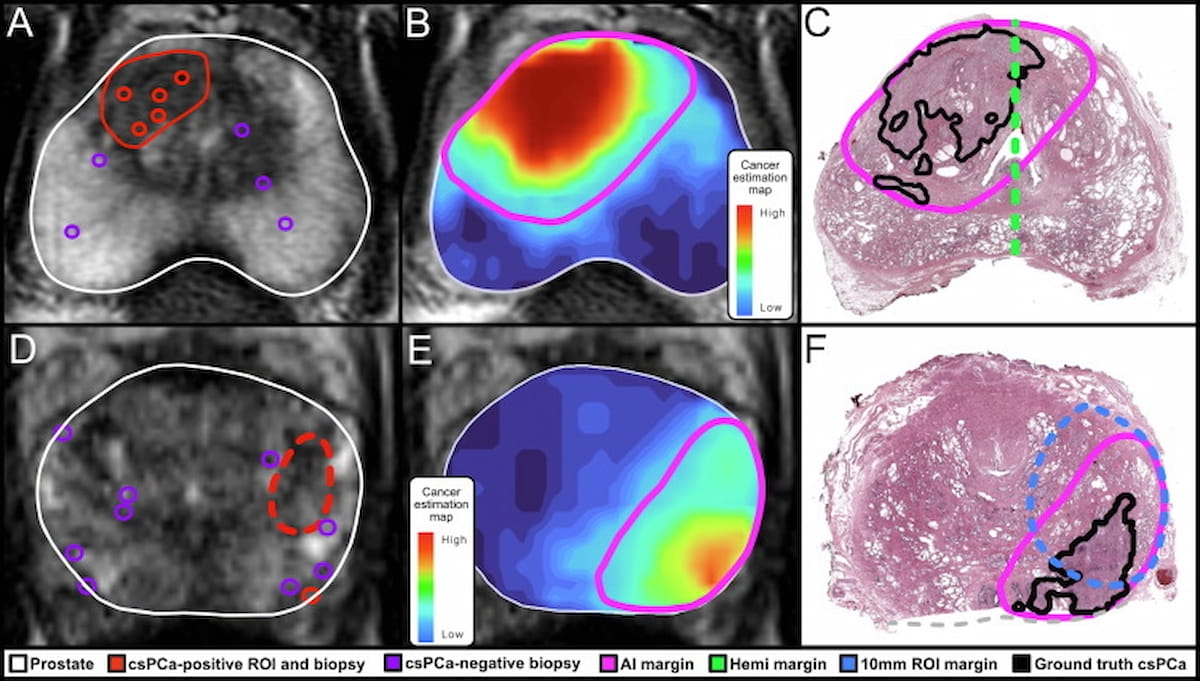Study Says AI Mapping More Effective than MRI for Assessing Extent of Prostate Cancer
Combining multimodal imaging data and biopsy data, an artificial intelligence (AI) model provided enhanced sensitivity for defining prostate cancer tumor margins in comparison to conventional magnetic resonance imaging (MRI) assessments.
Emerging research suggests that an artificial intelligence (AI) model, which can provide three-dimensional estimates of prostate cancer tumors and margins, may provide improved delineation of tumor margins as well as enhanced accuracy of negative margin probability for index tumors in comparison to magnetic resonance imaging (MRI).
For the retrospective study, published in European Urology Open Science, researchers compared AI-enabled mapping (Unfold AI, Avenda Health) with regions of interest (ROI) identified by conventional MRI, 10-mm ROI margins and hemigland margins for the delineation of prostate cancer tumor margins in 50 consecutive patients who had radical prostatectomy.
The AI model margins had a 96.9 percent sensitivity for identifying clinically significant prostate cancer (csPCa) in comparison to 37.4 percent for conventional MRI ROI, 93.2 percent for 10 mm ROI expansion and 94.1 percent for hemigland margins, according to the study.
The images above show two cases that reflect negative margins for the AI model assessment of index prostate lesions whereas hemigland margins were deemed positive (case A-C) and margins with 10-mm MRI region of interest (ROI) were deemed positive (case D-F). (Images courtesy of European Urology Open Science.)

The study authors noted the mean specificity rate for the AI model (51.8 percent) was significantly lower than that of conventional MRI ROI (97.9 percent) and the 10-mm ROI margins (63.4 percent). However, the researchers also found the mean extent of missed csPCa for the AI model was 1.6 mm in contrast to 3.8 mm for hemigland margins, 3.2 mm for 10-mm ROI margins and 12.0 mm for conventional MRI ROI. The AI software also had a negative margin rate of 90 percent for index lesions in comparison to 66 percent for hemigland margin assessment.
The study authors emphasized that contouring protocols with multiparametric MRI are not sufficient for targeted treatment of prostate cancer. The study findings also demonstrated significant advantages of the AI mapping software over hemigland margins, according to the researchers.
“In the independent test set, AI margins exceeded the negative margin rate of hemigland margins for both index lesions (90% vs. 66%) and any csPCa (80% vs. 56%),” wrote Geoffrey A. Sonn, M.D., an associate professor of urology at the Stanford University School of Medicine, and colleagues. “A combination of index lesion underestimation and csPCa-bearing satellite lesions caused hemigland margins to miss csPCa in nearly half of cases.”
(Editor’s note: For related content, see “Could an Emerging AI Platform Supplant Traditional MRI for Assessing Prostate Cancer?,” “Study Shows Benefits of AI for Prostate Cancer Detection on Multiparametric MRI” and “FDA Clears RadNet’s Updated AI Software for Prostate MRI.”)
The researchers said the combination of the AI software’s benefits with with the prognostic accuracy of the encapsulation confidence score (ECS) for negative margins could improve risk assessment and the selection of treatment options for patients with prostate cancer.
“This approach could help improve and standardize focal treatment margins, potentially reducing cancer recurrence rates,” noted Sonn and colleagues. “Furthermore, the ECS’s accurate assessment of negative margin likelihood and residual tumor risk could help facilitate informed decision-making for both patients and physicians.”
Beyond the inherent limitations of a single center study, the researchers acknowledged that the test cohort was comprised of patients who had a radical prostatectomy. Accordingly, these patients likely had more advanced prostate cancer than the average patient being treated with focal therapy, according to the study authors. The researchers also conceded that diffusion-weighted imaging, which has been documented to have a strong correlation with the presence of prostate tumors, was not included in the study algorithm.
New bpMRI Study Suggests AI Offers Comparable Results to Radiologists for PCa Detection
April 15th 2025Demonstrating no significant difference with radiologist detection of clinically significant prostate cancer (csPCa), a biparametric MRI-based AI model provided an 88.4 percent sensitivity rate in a recent study.
Expanded FDA Approval Allows Use of Pluvicto Prior to Chemotherapy in Patients with mCRPC
March 28th 2025Recent research demonstrated a 59 percent reduced risk of progression or death with the radioligand therapy Pluvicto in comparison to a change of androgen receptor pathway inhibitor (ARPI) for patients with metastatic castration-resistant prostate cancer (mCRPC).
Study: Monitoring of Prostate MRI Exams Could Lead to 75 Percent Reduction of Gadolinium Contrast
March 17th 2025While DCE MRI was deemed helpful in over 67 percent of cases in which it was used, researchers found that monitored prostate MRI exams, which facilitated a 75 percent reduction of DCE MRI sequences, had comparable sensitivity for prostate cancer as non-monitored exams.